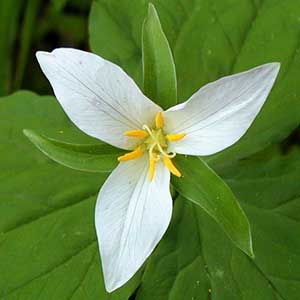Trillium stamineum
Trillium ovatum
Blue Ridge wakerobin, twisted trillium
Pacific trillium, trillium, western trillium, western wake-robin, western white trillium, white or western trillium, white trillium
horizontal, brownish, short, thick, praemorse, not brittle.
semierect to horizontal, short, stout, praemorse.
1–3, round in cross section, 1.5–3 dm, slender to stout, pilose-pubescent, rarely glabrous.
1–2, round, 2–5 dm, ± slender, glabrous.
held well above ground, sessile;
blade light silvery or bluish green with strong to faint mottling in darker colors, mottling becoming obscure with age, ovate-lanceolate to broadly ovate, 6.3–7.6 × 3.3–5 cm, larger bracts abaxially pilose-pubescent, margins entire, apex acute.
sessile, subsessile, or short-petiolate;
blade medium green, sometimes blotched and mottled, main veins prominent, ovate-rhombic, 7–12 × 5–20 cm, continuing to expand during anthesis, base rounded, apex acuminate.
erect, odor strong, of carrion;
sepals displayed above bracts, spreading to ± horizontal position, green, purple markings adaxially, lanceolate-elliptic, 17–40 mm, margins entire, purple, apex acuminate;
petals long-lasting, spreading and carried in ± horizontal position unlike any other sessile trillium, very deep maroon to blackish red, rarely yellow, purple-streaked, with 1–2 spiral twists, narrowly elliptic to lanceolate or linear, narrow, 1.5–3.8 × 0.3–0.6 cm, rarely broader, thick-textured, margins entire, apex sharply acute to rounded, tips incurving slightly;
stamens fully exposed, somewhat stiffly erect, dark purple, 16–24 mm, thick;
filaments dark purple, 2–4 mm, basally dilated;
anthers erect, straight, dark purple, 13–18 mm, thick, dehiscence extrorse;
connectives dark purple, straight, coarse, flat, ± not extended beyond anther sacs;
ovary dark purple, oval, 6-angled, 5–7 mm;
stigmas erect, widely spreading, often strongly recurved or recoiled, distinct, purple, linear, 4–10 mm, slightly thickened basally.
erect or nodding, odorless;
sepals spreading to horizontal, green, lanceolate to oblong-lanceolate, 15–50 × 6–20 mm, margins entire, apex acute;
petals erect-ascending, usually wide-spreading from base, exposing entire pistil, white or with pink or blush markings, lacking V-shaped markings, fading to rosy pink, purple, or dark red, veins not deeply engraved, ± linear to widely obovate, 1.5–7 ×1–4 cm, widest at or above middle, thin-textured, margins flat to undulate, apex acuminate;
stamens prominent, slightly recurved-spreading to straight, 10–18 mm;
filaments white, shorter than anthers, slender;
anthers yellow, 4–16 mm, slender, dehiscence latrorse-introrse;
ovary green or white, ovoid, 6-angled, 5–12 mm, attachment ± 3/4 ovary width;
stigmas recurved, barely connate basally, greenish white or white, linear, not lobed adaxially, 6–10 mm, uniformly thin;
pedicel erect to leaning, 2–6 cm.
baccate, purple, odorless, ovoid, strongly 6-angled, sometimes winged, 2 × 1–1.5 cm, pulpy, moist.
baccate, green or white, ± odorless, broadly ovoid, obscurely winged, 1.2–2.8 × 0.7–1.9 cm, pulpy-moist.
= 10.
= 10.
Trillium stamineum
Trillium ovatum
Varieties 2 (2 in the flora).
(Discussion copyrighted by Flora of North America; reprinted with permission.)
1. Bracts sessile; petals lanceolate to obovate, 1.5–7 × 1–4 cm | var. ovatum |
1. Bracts distinctly short-petiolate; petals linear to linear-lanceolate, 0.5–2.4 × 0.2–0.6 cm | var. oettingeri |
- Local floras:
BC,
CA,
OR,
WA
- Local Web sites:
CalFlora,
CalPhotos,
Flora NW,
PNW Herbaria,
Turner Photog.
WildflowerSearch
iNaturalist (observations)
USDA Plants Database
- LBJ Wildflower Center
- SEINet
- Plants of the World Online
- Encyclopedia of Life
- Wikipedia
- Google Image Search


